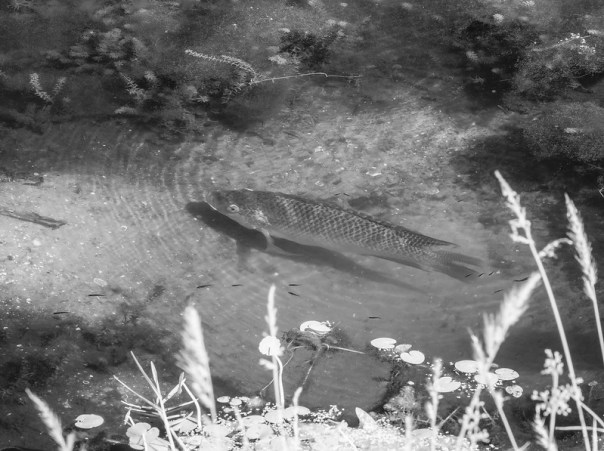When I began writing this post, I looked at the Circle B Bar Reserve category on my blog (https://edrosack.com/category/circle-b-bar-reserve/). To my surprise, once again it’s been about 2 years since my last visit! Every time I’m there I think I should go more often. This time I mean it – it’s a wonderful place!
It’s also a popular place – there’s a lot to see and a lot of people looking. Kevin M. and I went over last Saturday and here are some highlights from our visit.
 Great Horned Owl parent and chick
Great Horned Owl parent and chick
There’s been a Great Horned Owl nest along the entrance road for several years. It’s marked off with tape and signs and there’s usually a crowd observing so you can’t miss it. The image above is a composite. They didn’t both look toward me at the same time, so I combined two exposures in Photoshop. The chick seems pretty large. I’m guessing it must be several weeks old. They grow fast – go over soon if you want to see it before it fledges.
 Cooper’s Hawk
Cooper’s Hawk
This hawk startled several birds (and me) when it launched towards a coot on the surface of the canal by Marsh Rabbit Run. It missed and then stayed in this tree for a bit before moving on. I almost didn’t make the photo, since at first glance, it looked like a Red-shoulder Hawk to me. But luckily someone nearby said “That’s a nice Cooper’s”, which is a new life bird for me. It’s young so the colors aren’t typical for an adult, but the eyes give it away.
I also tried one of the features in the new firmware for the Olympus E-M1 MII camera: Pro Capture (hi) mode with the PL 100 – 400 lens. I wanted to catch the bird as it launched off the branch. It didn’t quite work because hi speed Pro Capture freezes focus after the first shot. It took off at an angle toward the camera and the bird isn’t sharp in the frame. Oh well, another thing to add to my ‘try again’ list.
 Pig and People
Pig and People
This wild pig was foraging along the Heron Hideout path. It’s pretty small, seemed very calm and used to all the curious people, and minded its own business. But I’d still be cautious around it.
 Gray Catbird – infrared, monochrome
Gray Catbird – infrared, monochrome
I forgot the spare battery for my main camera back in the car and of course it died on our hike just after the hawk photo. But I also had my IR camera with me with plenty of battery left. So I switched my long lens over to it and kept shooting. We spotted this Gray Catbird in the bushes, and I like the way the bird stands out from the vegetation in IR converted to B&W.
 Cedar Waxwing @ Circle B (Photo by Kevin McKinney, used with permission)
Cedar Waxwing @ Circle B (Photo by Kevin McKinney, used with permission)
We found a flock of Cedar Waxwings in the branches above the path – but my photos of them are in infrared too. Unlike me, Kevin was prepared and he was kind enough to let me use one of his from the day for this post.
Since it’s a long drive, we got lazy and slept in – so no sunrise images. I did make some infrared landscapes there and I’m planning to use them in a future post, so check back for that. Maybe I’ll include the IR Waxwings too.
We usually walk down Alligator Alley but it’s closed. The gators are apparently active in that area although we didn’t spot any. We did spot Painted Buntings, Indigo Buntings, a Barred Owl, Blue Wing Teals, Double Crested Cormorants, Anhingas, American Coots and chicks, a Purple Gallinule, the usual Herons and Egrets, Roseate Spoonbills, Warblers, Bald Eagles, Ospreys, turtles, and more. Like I said – a lot to see!
You can view more Circle B Bar Reserve photos in my album on Flickr (https://www.flickr.com/photos/edrosack/albums/72157625343566505) and in Kevin’s (https://www.flickr.com/photos/44542650@N08/albums/72157666796492018).
Thanks for stopping by and reading the blog. Now – go make some photos!
©2018, Ed Rosack and Kevin McKinney. All rights reserved
 Dawn in a calm, peaceful, and pretty place
Dawn in a calm, peaceful, and pretty place













































